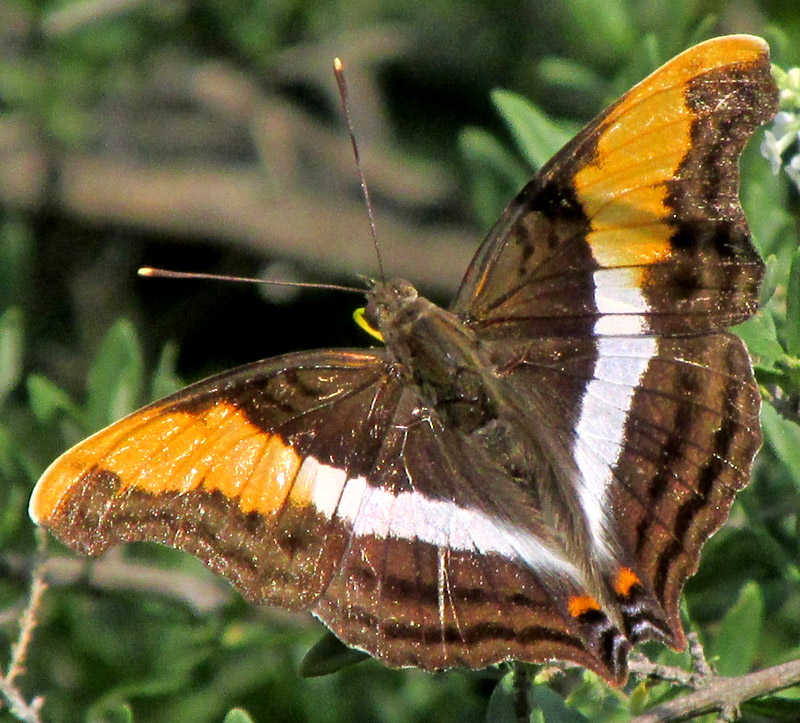Excerpts from Jim Conrad's
Naturalist Newsletter
entry dated May 25, 2023, issued from near Tequisquiapan, elevation about 1,900m (6200 ft), Querétaro state, MÉXICO
(~N20.55°, ~W99.89°)
SILVER EMPEROR

I'd been thinking the above species of butterfly -- this one spotted in mid morning basking in sunlight on a flowering branch of Whitebrush -- was the same species as the "sister butterflies" commonly seen flying fast and conspicuously across much of Mexico. In the Yucatan we had the Massilia Sister, which at first glance looks like the butterfly pictured above.
However, notice that in the above picture the white wing streaks dissolve into orange as they approach the forewing's front edge. The Massilia Sister's white bars end well before the forewing's top, and its orange spots are well separated from the white streak.
Sister butterflies are members of the genus Adelpha. Keith Willmott's 2003 revision of the genus entitled "The Genus Adelpha: Its Systematics, Biology and Biogeography (Lepidoptera: Nymphalidae: Limenitidini)" reports 85 Adelpha species, so surely the butterfly pictured above was one of those.
However, when the above image was shipped off to volunteer butterfly identifier Bea in Ontario, it turned out that ours wasn't an Adelpha sister at all, but rather the Silver Emperor, DOXOCOPA LAURE.
This was a surprise. The genera Doxocopoa and Adelpha are members of the same huge Brush-footed Buttery Family, the Nymphalidae, but they belong to different subfamilies, so they're not very closely related.
Our Silver Emperor species occurs from the dryer parts of the US Southwest near the border with Mexico, south throughout Mexico and Central America deep into South America, as well as Cuba. Males display some blue iridescence on their uppersides, but females don't. The above individual displayed no iridescence. Females lay eggs on members of the Elm Family, on which later the caterpillars feed. Appropriately enough, nearby the Whitebrush stood several Desert Hackberries, which belong to the Elm Family.
Adult Silver Emperors, though, feed on rotting fruit, dung, sap and carrion. The butterfly in our picture seems to have her proboscis extended as if feeding on the Whitebrush's flowers, but maybe she was just drinking dew, or simply stretching her proboscis.
But, what about this matter of our Silver Emperor looking so much like various Sister butterflies?
A general understanding in butterfly studies, lepidopterology, is that when butterfly species are inedible, they advertise their unpalatabality by displaying bright colors and bold patterning, and often flying fast out in the open as if they had nothing to fear. Predators come to associate these general characteristics with inedibility.
This has long been noticed, but it's been hard to prove scientifically. However, experimental results from the 2021 study by Erika Páez and others entitled "Hard to catch: experimental evidence" supported the idea. Páez's team found evidence that "... predators can learn and generalize to some extent naturally occurring colour pattern signals that are associated with the escaping ability of prey."
They further suggested that "evasive mimicry" could explain "colour pattern convergence" in fast-moving prey, such as Adelpha butterflies." By "convergence" they refer to convergent evolution, which takes place when different species evolve independently toward the same appearance and behavior because it offers maximum survivability. By the way, our Silver Emperor not only looks like various sister species, but also like them it flutters about in plain view.
And so, one might guess that Emperor/Doxocopa species went through a period of convergent evolution with Sister/Adelpha species, with the result that our Silver Emperor, by looking and acting like other flashy, out-in-the-open species, exhibits "evasive mimicry."
You just never know what kind of interesting story lies behind the most common, average-looking butterfly.